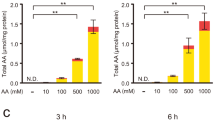Abstract
Growth factor receptors transmit biological signals for the stimulation of cell growth in vitro and in vivo and their autocrine stimulation may be involved in tumorigenesis. It is therefore, of great value to understand receptor reactions in response to ultraviolet (UV) light which certain normal human cells are invaribly exposed to during their growth cycle. UV irradiation has recently been shown to deplete antioxidant enzymes in human skin. The aims of the present study were a) to compare the lateral mobility of epidermal growth factor receptors (EGF-R) in cultured human keratinocytes and human foreskin fibroblasts, b) to investigate effects of ultraviolet B radiation on the mobility of EGF-R in these cells, and c) study the response of EGF-R on addition of antioxidant enzymes. The epidermal growth factor receptors were labeled with rhodaminated EGF, the lateral diffusion was determined and the fraction of mobile EGF-R assessed with the fluorescence recovery after photobleaching (FRAP). We found that human keratinocytes display a higher basal level of EGF-R mobility than human skin fibroblasts, viz. with diffusion coefficients (D ± standard error of the mean, SEM) of 4.2±0.2 × 10−10 cm2/s, and 1.8±0.2 × 10−10 cm2/s, respectively. UVB-irradiated fibroblasts showed an almost four-fold increase in the diffusion coefficient; D was 6.3±0.3 × 10−10 cm2/s. The keratinocytes, however, displayed no significant increase in receptor diffusion after irradiation; D was 5.1±0.8 × 10−10 cm2/s. In both cell types the percentage of EGF-R fluorescence recovery after photobleaching, i.e. the fraction of mobile receptors, was significantly increased after irradiation. In keratinocytes it increased from 69% before irradiation to 78% after irradiation. Analogous figures for fibroblasts were 61% and 73%. The effect of UVB on fibroblast receptors was abolished by prior addition of superoxide dismutase (SOD) and catalase (CAT). It is concluded that UVB radiation of fibroblasts and keratinocytes can affect their biophysical properties of EGF-R. The finding that addition of antioxidant enzymes prevented the UVB effect in fibroblasts may indicate the involvement of reactive oxygen metabolites.
Similar content being viewed by others
Abbreviations
- CAT:
-
Catalase
- D:
-
Lateral diffusion coefficient
- EDTA:
-
Ethylenediaminetetraacetic acid
- EGF:
-
Epidermal growth factor
- E-MEM:
-
Eagle's minimum essential medium
- FCS:
-
Fetal calf serum
- FRAP:
-
Fluorescence recovery after photobleaching
- KRG:
-
Krebs-Ringer phosphate buffer
- PBS:
-
Phosphate-buffered saline
- R:
-
Mobile fraction
- ROS:
-
Reactive oxygen species
- SEM:
-
Standard error of the mean
- SOD:
-
Superoxide dismutase
- UVA:
-
Ultraviolet light-A (315-400 nm)
- UVB:
-
Ultraviolet light-B (280-315 nm)
References
Axelrod, D., Koppel, D. E., Schlessinger, J., Elson, E. L. and Webb, W. W. (1976)Biophys. J. 16:1055–1069.
Brawn, K. and Fridovich, I. (1981)Arch. Biochem. Biophys. 206:414–419.
Cross, C. C., Halliwell, B., Borish, E. T., Pryor, W. A., Ames, B. N., Saul, R. L., McCord, J. M. and Harman, D. (1987)Ann. Intern. Med. 107:526–545.
Crutzen, P. J. (1992)Nature 356:104–105.
Darr, D. and Fridovich, I. (1994)J. Invest Dermatol 102:671–675.
De Leo, V. A., Horlick, H., Hanson, D., Eisenger, M. and Harber, L. C. (1984)J. Invest. Dermatol. 83:323–326.
Dobretsov, G. E., Borschevska, T. A., Petrov, V. A. and Vladimirov, Y. A. (1977)FEBS 84:125–128.
Fuchs, J., Hufleit, M., Rothfuss, L., Wilson, D., Caramo, G. and Packer, L. (1990) In:Antioxidants in Therapy and Preventive Medicine. Plenum Press, New York, 533–536.
Gilchrest, B. A., Soter, N. A., Stoff, J. S. and Hihm, M. C. (1981)J. Am. Acad. Dermatol. 5:411–422.
Guttridge, J. M. C. and Halliwell, B. (1990)TIBS 15:129–135.
Halliwell, B. and Aruoma, O. I. (1991)FEBS Lett 1–2:9–19.
Hudson, L. and Hay, F. C. (1980) In:Practical Immunology. Second ed. Blackwell Scientific Publications, Oxford, 11–12.
Jacobson, K., Derzko, Z., Wu, E. S., Hou, Y. and Poste, G. J. (1977)J. Supramol. Struct. 5:565–576.
Johansson, B., Sundqvist, T. and Magnusson, K. -E. (1987)Cell. Biophys. 10:233–244.
Johansson, B. and Magnusson, K. -E. (1990)Inflammation 14:631–644.
Jurkiewicz, B. A. and Buettner, G. R. (1994)Photochem Photobiology 59:1–4.
Koppel, D. E., Sheetz, M. P. and Schindler, M. (1981)Proc. Natl. Acad. Sci. USA 78:3576–3580.
Maeda, K., Naganuma, M. and Fukuda, M. (1991)Photochem Photobiology 54:737–740.
Matsui, M. S., Laufer, L., Scheide, S. and DeLeo, V. (1989)J. Invest. Dermatol. 92:617–622.
Miyachi, Y., Inamura, S. and Niwa, Y. (1987)J. Invest. Dermatol. 89:111–112.
Ohta, A., Mohri, T. and Ohyashiki, T. (1989)Biochem. Biophys. 984:151–157.
Peak, J. G., Peak, M. J., Sikorski, R. S. and Jones, C. A. (1985)Photochem. Photobiol. 41:295–302.
Pence, B. C. and Naylor, M. F. (1990)J. Invest. Dermatol. 95:213–216.
Peters, R. (1981)Cell. Biol. Int. Rep. 5:733–760.
Ponec, M., Kempenaar, J., Weerheim, A. and Boonstra, J. (1987)J. Cell. Physiol. 133:358–364.
Punnonen, K., Puntala, A., Jansen, C. T. and Ahotupa, M. A. (1991)Acta Derm. Venerol. (Stockh) 71:239–273.
Punnonen, K., Puustinen, T. and Jansen, C. T. Arch. (1986)Dermatol. Res. 278:441–444.
Punnonen, K., Puustinen, T. C. and Jansen, T. (1987)J. Invest. Dermatol. 88:611–614.
Rheinwald, J. C. and Green, H. (1975)Cell 6:331–344.
Schlessinger, J., Axelrod, D., Koppel, D. E., Webb, W. W. and Elson, E. L. (1977)Science 195:307–309.
Schlessinger, J., Schechter, Y., Cuatrecasas, P., Willingham, M. C. and Pastan, D. (1978)Proc. Natl. Acad. Sci. USA 75:2659–2663.
Shindo, Y., Witt, E. and Packer, L. (1993)J. Invest. Dermatol. 100:260–265.
Stubbs, C. D. and Smith, A. D. (1984)Biochem. Biophys. Acta 779:89–137.
Zidovetzki, R., Yarden, Y., Schlessinger, J. and Jovin, T. M. (1981)Proc. Natl. Acad. Sci. USA 78:6981–6985.
Author information
Authors and Affiliations
Rights and permissions
About this article
Cite this article
Lirvall, M., Ljungqvist-Höddelius, P., Wasteson, Å. et al. UVB radiation affects the mobility of epidermal growth factor receptors in human keratinocytes and fibroblasts. Biosci Rep 16, 227–238 (1996). https://doi.org/10.1007/BF01207337
Received:
Accepted:
Issue Date:
DOI: https://doi.org/10.1007/BF01207337




